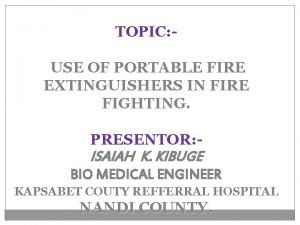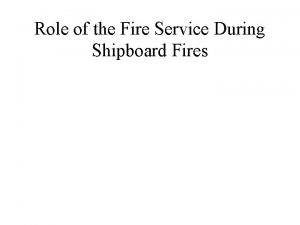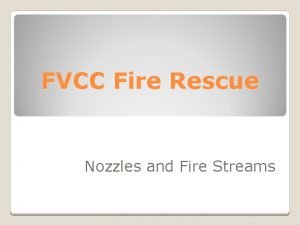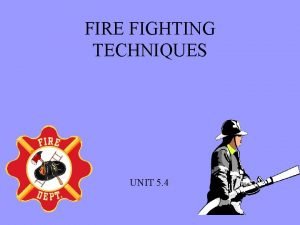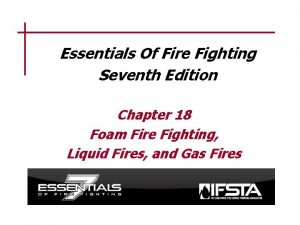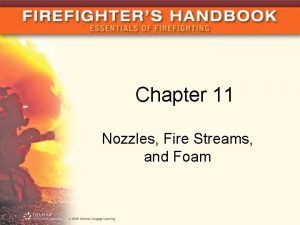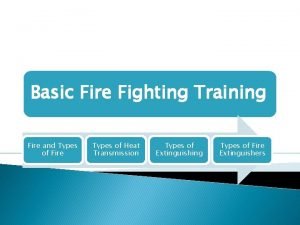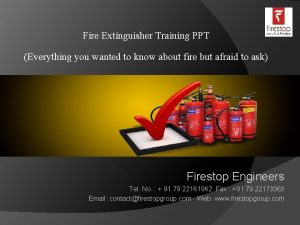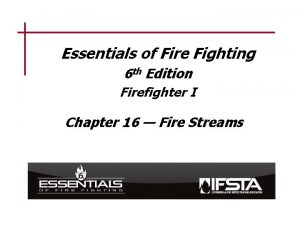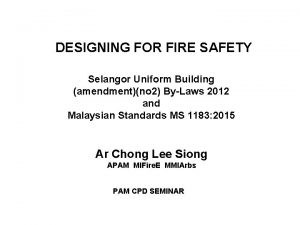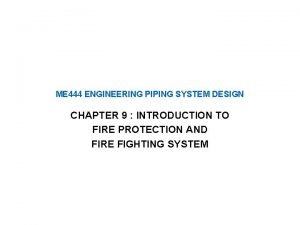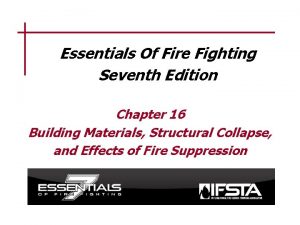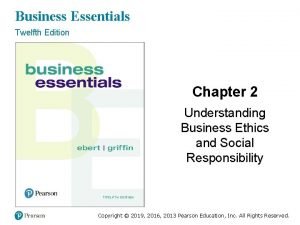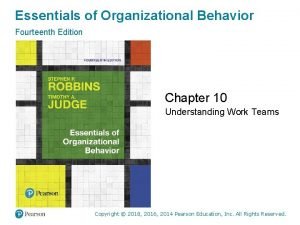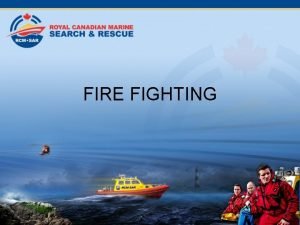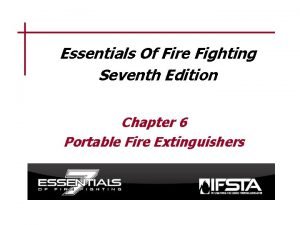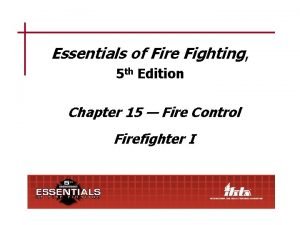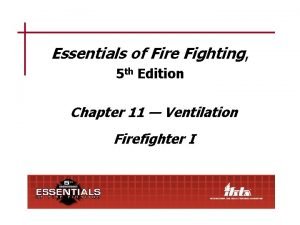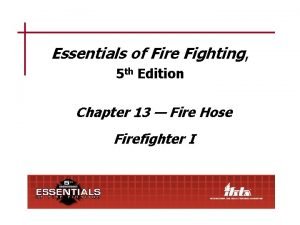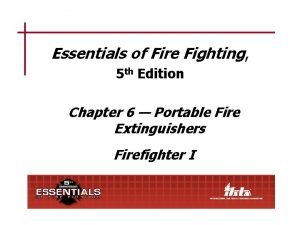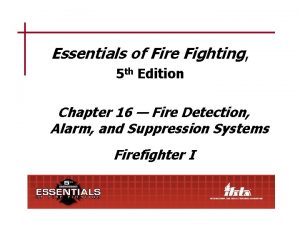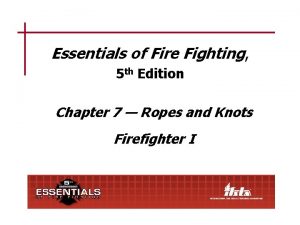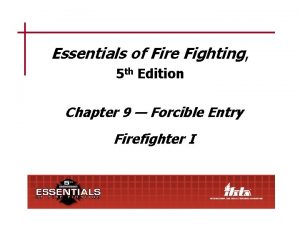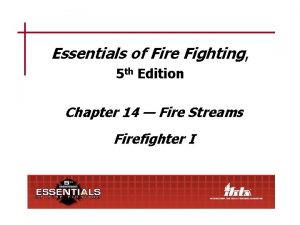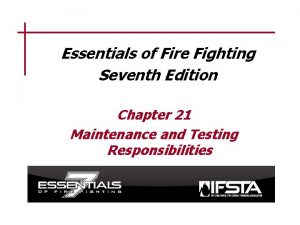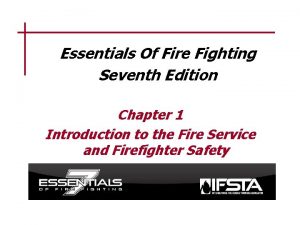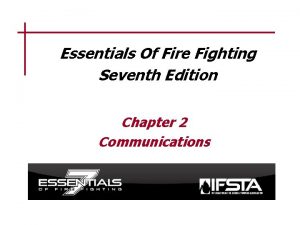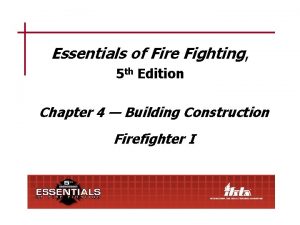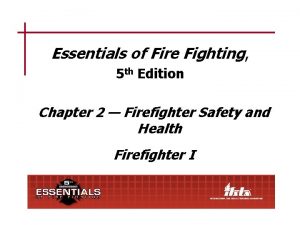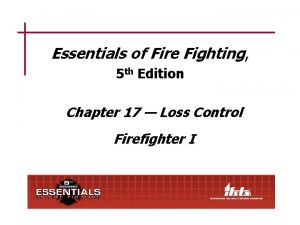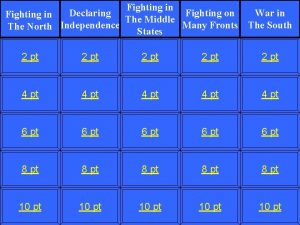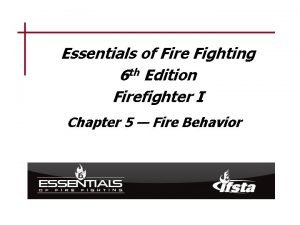Essentials of Fire Fighting 5 th Edition Chapter



































- Slides: 35

Essentials of Fire Fighting, 5 th Edition Chapter 12 — Water Supply Firefighter I

Chapter 12 Lesson Goal • After completing this lesson, the student shall be able to make hydrant connections and draft from a static water source according to the authority having jurisdiction (AHJ). Firefighter I 1

Specific Objectives 1. Describe dry-barrel and wetbarrel hydrants. 2. Discuss fire hydrant marking and location. 3. Summarize potential problems to look for when inspecting fire hydrants. (Continued) Firefighter I 2

Specific Objectives 4. Explain the process of fire hydrant testing. 5. Discuss alternative water supplies. 6. Discuss rural water supply operations. 7. Operate a hydrant. (Skill Sheet (Continued) 12 -I-1) Firefighter I 3

Specific Objectives 8. Make soft-sleeve and hardsuction hydrant connections. (Skill Sheet 12 -I-2) 9. Connect and place a hardsuction hose for drafting from a static water source. (Skill Sheet 12 -I-3) 10. Deploy a portable water tank. (Skill Sheet 12 -I-4) Firefighter I 4

Hydrants • Usually made of cast iron with bronze working parts • Must be opened and closed slowly to prevent damage Firefighter I 5

Dry-Barrel Hydrants • Installed in areas where prolonged periods of subfreezing weather are common • Have main valve located below frost line that prevents water from entering hydrant barrel Firefighter I 6 (Continued)

Dry-Barrel Hydrants • Operation • Must be completely open or closed to prevent leaking • When shutting down, verify that water left in hydrant barrel is draining out (Continued) Firefighter I 7

Dry-Barrel Hydrants • In some areas, hydrants must be pumped out after each use to prevent water contamination • If water is bubbling out of ground, broken component in barrel is allowing water to get past drain opening Firefighter I 8

Wet-Barrel Hydrants • Installed in warmer climates where prolonged periods of subfreezing weather uncommon • Horizontal compressiontype valve at each outlet • Always filled with water Firefighter I 9

Fire Hydrant Marking • Rate of flow from individual hydrants varies for several reasons • NFPA® has developed system of marking hydrants • Local color-coding may differ from NFPA® Firefighter I 10

Fire Hydrant Locations • Decisions usually made by water department personnel based on recommendations from fire department • Should not be spaced more than 300 feet (100 m) apart in high-value districts (Continued) Firefighter I 11

Fire Hydrant Locations • Locate hydrant at every other intersection • Intermediate hydrants may be required where distances between intersections exceed 350 to 400 feet (105 to 120 m) • Other factors affect location/spacing Firefighter I 12

Hydrant Testing and Inspections • Responsibility of fire department personnel • Firefighters should look for wide array of items Firefighter I 13

Fire Hydrant Testing Process • Many departments no longer responsible for testing • Most basic test normally conducted is flow test Firefighter I 14

Flow Test Steps • • • Select hydrant Remove all outlet caps Inspect outlet threads Lubricate all outlet threads Replace all caps except one 2½-inch (65 mm) cap (Continued) Firefighter I 15

Flow Test Steps • Connect cap-type pressure gauge to outlet on second hydrant nearby • Turn second hydrant on, record static pressure • Turn test hydrant on fully, allow water to flow briefly (Continued) Firefighter I 16

Flow Test Steps • Use pitot tube, gauge to measure flow rate • Record pitot gauge reading • Take/record residual pressure reading from gauge connected to second hydrant before shutting test hydrant off (Continued) Firefighter I 17

Flow Test Steps • Turn off second hydrant, remove gauge, • • replace cap Turn off test hydrant Test for vacuum created by operating drain valve (dry barrel) Replace cap on outlet Repeat procedure with each hydrant Firefighter I 18

Alternative Water Supply Sources • • Lakes Ponds Rivers Ocean Swimming pools Farm stock tanks Underground cisterns Firefighter I 19

Drafting From Alternative Water Supplies • Process of drawing water from static source to pumper • Can use almost any static source of water if sufficient in quantity, not contaminated • Depth of water from which to draft Firefighter I 20

Dry Hydrants • Installed at static water sources to increase water supply available • Usually constructed of steel or PVC pipe with strainers at water source, steamer ports to connect to pumper • Designed to supply at least 1, 000 gpm (4 000 L/min) (Continued) Firefighter I 21

Water Shuttles • Involve hauling water from supply source to portable tanks from which water may be drawn to fight fire • Recommended for distances greater than ½ mile (0. 8 km) or greater than the fire department’s capability of laying supply hoselines (Continued) Firefighter I 22

Water Shuttles • Critical elements – Fast-fill, fast-dump capabilities – Water supply officers at fill/dump sites – Traffic control – Hydrant operations – Hookups – Tank venting Firefighter I 23

Water Shuttles • Key components • Dump site • Portable tanks (Continued) Firefighter I 24

Water Shuttles • Ways in which water tenders unload – Gravity dumping – Jet dumps that increase flow rate – Apparatus-mounted pumps – Combination of these methods (Continued) Firefighter I 25

Water Shuttles • According to NFPA® 1901, water tenders on level ground should be capable of dumping/filling at rates of at least 1, 000 gpm (4 000 L/min) (Continued) Firefighter I 26

Water Shuttles • To fill water tenders quickly, use best fill site, large hoselines, multiple hoselines • Multiple portable pumps may be necessary Firefighter I 27

Relay Pumping • Can be used in situations where water source is close enough to fire scene to render water shuttles unnecessary • Factors to consider – Water supply must be capable of maintaining desired volume of water – Relay must be established quickly (Continued) Firefighter I 28

Relay Pumping • Determining number of pumpers needed and distance between them – Several factors to take into account – Apparatus with greatest pumping capacity should be at water source (Continued) Firefighter I 29

Relay Pumping • Determining number of pumpers needed and distance between them – Large-diameter hose or multiple hoselines increase distance, volume a relay can supply – Water supply officer should consider all factors and determine correct distance Firefighter I 30

Summary • Because water is still the primary fire extinguishing agent used by firefighters in North America, and because fires often occur considerable distances from major water sources, fire departments must develop ways to transport available water from its source to where it is needed. (Continued) Firefighter I 31

Summary • Firefighters must know what water supply systems have been developed and what their responsibilities are when these systems are used. Firefighter I 32

Review Questions 1. What is the difference between dry-barrel and wet-barrel hydrants? 2. How are fire hydrants marked? 3. What factors affect hydrant location and spacing? (Continued) Firefighter I 33

Review Questions 4. List alternative water supplies. 5. What are three key components of a water shuttle operation? Firefighter I 34
 Business essentials 12th edition chapter 1
Business essentials 12th edition chapter 1 Starvation method of extinguishing fire
Starvation method of extinguishing fire Shipboard fire fighting organization
Shipboard fire fighting organization Broken stream nozzle
Broken stream nozzle Siphip
Siphip Fire fighting methods
Fire fighting methods At a bulk transport incident, firefighters must:
At a bulk transport incident, firefighters must: Rain down foam application method
Rain down foam application method Fire fighting methods
Fire fighting methods Foam pro 1600
Foam pro 1600 Fire training ppt
Fire training ppt Negative pressure ventilation firefighting
Negative pressure ventilation firefighting Broken stream nozzle
Broken stream nozzle Ms 1183:2015
Ms 1183:2015 New age company llc
New age company llc Fire sprinkler head gpm chart
Fire sprinkler head gpm chart Network security essentials 5th edition pdf
Network security essentials 5th edition pdf Essentials of investments 11th edition
Essentials of investments 11th edition Understanding business 12th edition chapter 1
Understanding business 12th edition chapter 1 Essentials of sociology 5th edition
Essentials of sociology 5th edition Firefighter essentials 7th edition
Firefighter essentials 7th edition Business essentials 12th edition
Business essentials 12th edition Management information systems 13th edition
Management information systems 13th edition Essentials of organizational behavior 14th edition
Essentials of organizational behavior 14th edition Cryptographic systems are generically classified by
Cryptographic systems are generically classified by Criminal justice the essentials 5th edition
Criminal justice the essentials 5th edition Chapter 40 fighting the cold war at home
Chapter 40 fighting the cold war at home Mis chapter 6
Mis chapter 6 Using mis 10th edition
Using mis 10th edition Neo luddite criticisms of computer technology
Neo luddite criticisms of computer technology A gift of fire 4th edition
A gift of fire 4th edition Reichstag fire who was the fire starter
Reichstag fire who was the fire starter Damper fire alarm
Damper fire alarm Uttar pradesh fire prevention & fire safety rules, 2005
Uttar pradesh fire prevention & fire safety rules, 2005 Rwi are
Rwi are Fight fire with fire definition
Fight fire with fire definition

